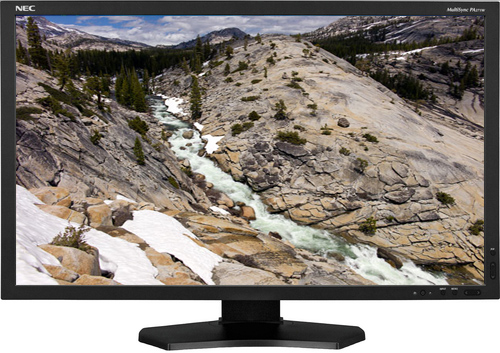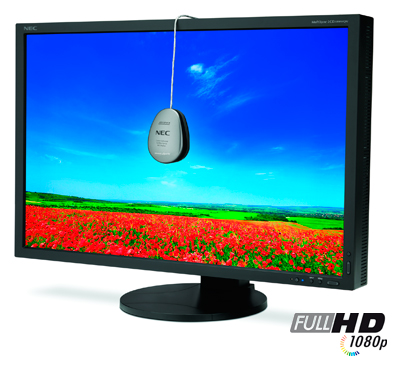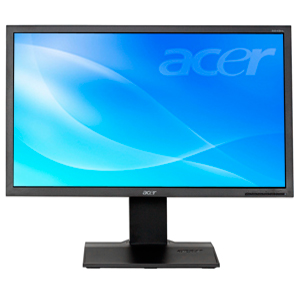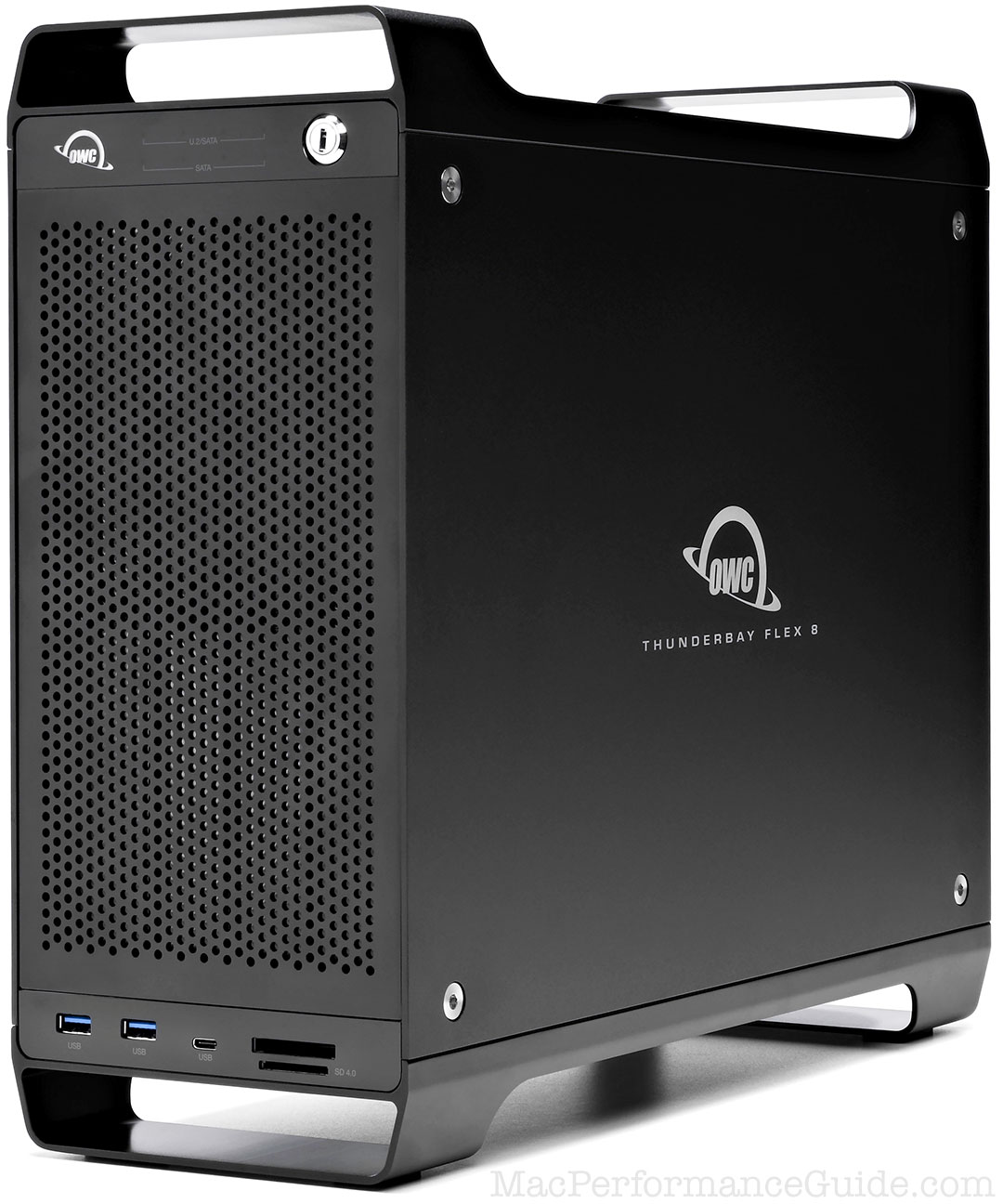
$220 SAVE $130 = 37.0% Western Digital 16.0TB Western Digital Ultrastar DC HC550 3.5-in… in Storage: Hard Drives
|

|

|

|

|

|

|

|

|

|
Buyer's Guide: Displays
Related: color space and gamut, display connectivity, How-To, laptop, MacBook, MacBook Pro, Other World Computing
This page covers recommended displays. If you’re looking for a good value, see the Acer B243HL, below.
Displays are hard to recommend without using them extensively, so the list is short.
Photographers serious about color gamut and grayscale should be looking beyond the Apple displays
Recommended display — NEC 27" PA271W top pick!
The new (June 2010) NEC PA271W widescreen display is awesome, read my review. If anything, it’s a little better than the NEC 30".
I use two NEC displays— the 30" as my main display, and the 27-inch as a second monitor, vertically, which makes for a luxurious web-browsing experience.
The 27-inch model is a little smaller — about two inches less wide, even though its resolution is identical horizontally. However, it’s 1440 pixels high instead of the 1600 pixels the 30-inch model.
Recommended display — NEC 30" or other size top pick! PERMALINK
Photographers serious about color gamut and grayscale should be looking beyond the Apple displays.
I bought my NEC 30" from OWC in February 2009, and I’m extremely pleased with it. While OWC’s pricing might be a little higher than some vendors, they stand behind what they sell, and shipping is free during the holiday season and some other times— and shipping isn’t cheap on this huge box.
The NEC 30" LCD 3090WQXi is fantastic in terms of size, color gamut, grayscale uniformity, and clarity. It is also superb for reading text or everyday tasks. You’ll see color you never saw before, especially important for newer DSLRs with wide color gamuts. For my thoughts on this display, see A tale of two gamuts.
You can get the NEC 30" LCD 3090WQXi at OWC, and be sure to get the model with the bundled calibrator, which adjusts the monitor internals in 12 bits, far better than tweaking the video card in 8 bits as an add-on calibrator would. The monitor/calibrator bundle generally ends with a product code of “SV”.
NEC also has other size models with similar color gamut and quality, just be sure to get the 12-bit bundled calibrator with the display. If OWC doesn’t have the model you’re looking for, give OWC a call.
When you get the NEC display, be sure to get the latest version of Spectra View II software.
Click the image below to get one at OWC.
Apple displays PERMALINK
Apple displays are excellent in many ways, but there are multiple issues to understand.
First, the glossy surface on most models is mirror-like and headache-inducing if the ambient light cannot be controlled. Some people are OK with this, but definitely take a look before buying.
Second, Apple displays use the Mini DisplayPort, which makes them all but useless on anything except current Macs. While there might be adapters that work, I've have bad experience with adapters.
Third, Apple displays are not the best choice for photographers seeking high color accuracy and grayscale uniformity. The mirror-like finish on most models can also mislead as to how a print will look. I have two (2) of the Apple 30" displays (pre-2009 models, matte screen), and they are obviously inferior to the NEC 30" in terms of color gamut and grayscale uniformity, not to mention the green crawlies. Sometime in late 2009 or 2010 Apple will likely introduce a new 30" display.
Fourth, Apple offers no calibration hardware of any kind, certainly not anything that can adjust any of its monitors internally to 10/12 bits or more. You can get a 3rd-party calibrator, but this means tweaking the video card in 8 bits, a grossly inferior approach over adjusting the monitor itself in 12 bits, and one that I’ve repeatedly been dissatisfied with in the past, with multiple hardware calibrators.
Acer B243HL mbdrz 24" widescreen display PERMALINK
The Acer B243HL is an entry level display offering 1920 X 1080 resolution with a matte-finish screen. The viewable area is exactly 21" wide.
I generally avoid “starter” displays. But after connecting it to my MacBook Pro, I concluded that this is a display I could be happy with for a palette monitor, or for any standard usage: email, web browsing, etc. I would certainly prefer it for day-long use over the cramped MacBook Pro 17" screen.
At about $296 with a three year warranty, it’s a great value for a 24" display.
8-bay Thunderbolt 3
2.5 or 3.5 inch hard drives, NVMe SSD, USB-C, USB-A, DisplayPort 1.4, SD slot, PCIe slot, 500W power supply.
Non-RAID or RAID-0/1/4/5/10.
Capacities up to 128 Terabytes!
Image display and color
After a very basic calibration using Apple’s built-in display calibration (I used no hardware), I brought up diglloyd.com to look at a variety of photographs (here are some). I was favorably impressed; color looked very pleasing and reasonably accurate; nothing was obviously off.
I did not assess gamut, but grayscale uniformity was very good.
Narrow viewing angle
Vertical viewing angle (top to bottom) is troublesome; a modest change in viewing angle shifts the brightness swiftly— slump a little in your chair and things change.
More problematic, the top of the screen can be seen to be darker than the bottom. So the Acer is not a good choice for gauging color or density. In other words, it is a poor choice for working with images and trying to adjust them.
Text display and pixel density
I put the MacBook Pro into display mirror mode so that the built-in MBP display and the Acer displayed the same image.
I then examined the display of text, and here something caught my eye: the anti-aliased text display on the Acer has a coarse look to it. On the MacBook Pro 17" display (matte screen), the anti-aliasing effect produces very smooth and clean text even on italic text, such as with the index page of MacPerformanceGuide. On the Acer, the text looks granular/coarse at the edges. Quite probably Apple has optimized the anti-aliasing feature for its own screens; the algorithm fares less well on the Acer.
But perhaps there is more to it than that— both screens display 1920 pixels wide, but the Acer displays those 1920 pixels in a 21" wide area, compared to the 14.5" of the Macbook Pro. That’s 91dpi for the Acer and an eye-straining 132dpi for the built-in MacBook Pro display.
Those larger letters make the anti-aliasing effect more obvious. It caught my attention, but I did not see it as a negative. I felt that the enlarged display was easier on the eyes, and it felt luxurious compared to the cramped screen of the MacBook Pro 17". All these factors can engage both visual acuity and personal preferences, but my conclusions was that I’d prefer the Acer for everyday tasks.
DVI adapter
Since it's a standard DVI display, you’ll also need a MiniDisplayPort-to-DVI adapter for use on a Mac laptop and/or a second display on current Mac Pros.
Seagate 22TB IronWolf Pro 7200 rpm SATA III 3.5" Internal NAS HDD (CMR)
SAVE $60

 diglloydTools™
diglloydTools™





